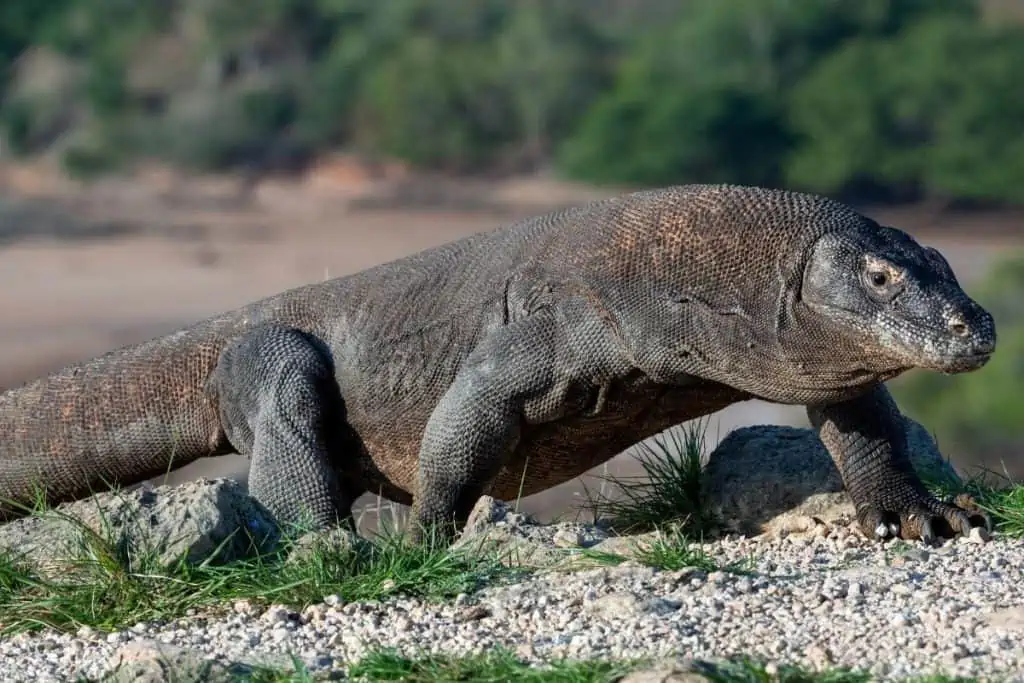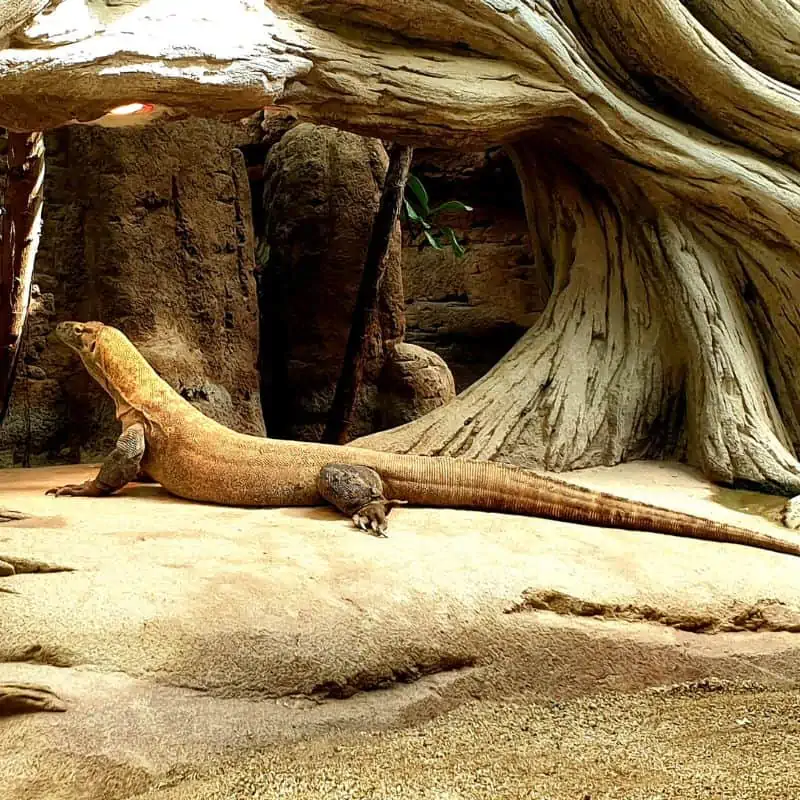Komodo Dragons may seem like ancient creatures that have been around forever, but unlike the dragons of myth, they’re not immortal. So, how long do Komodo Dragons live then?
Komodo dragons can live up to thirty years and take about eight to nine years to reach sexual maturity. Komodo dragons can live for twenty to thirty years in captivity. All Komodos are solitary and territorial. Since they’re only found in Indonesia, they share similar environments and resources.
While there is next to nothing that proves to be a risk to an adult Komodo dragon, juvenile Komodo dragons are still preyed upon. So, in this article, we’re diving into all you need to know about the Komodo dragon’s lifespan.

How Long Is the Komodo Dragon’s Lifespan?
A Komodo Dragon has a lifespan of approximately 30 years.
While thirty years long, the lifespan is threatened long before the eggs even hatch. The eggs are laid together and called a clutch.
Numerous eggs are never fertilized, and predators like wild pigs or other Komodo dragons occasionally devour entire clutches.
If you’re wondering how scientists figured out the lifespan of a Komodo dragon in the first place, that’s thanks to the oldest living Komodo dragon from Calgary Zoo, which died in 2016.
The 30-year-old dragon, Loka, was treated as a “geriatric animal,” according to Calgary Zoo. Geriatrics, sometimes known as geriatric medicine, is a branch of medicine that focuses on treating the unique medical requirements of older people.
Given that a Komodo dragon kept in captivity lived to be thirty years old, the longevity of these creatures may vary in the wild.
Komodo dragons are provided with competent care and food, which makes life easier for them. In addition, they don’t have many natural or human threats, which also increases their lifespan.
The added life security in captivity is likely a reason for Komodo dragons living longer in captivity.

What Is Komodo Dragon’s Lifecycle?
Every year in September, these dragons often lay 20–25 eggs. The Komodo dragon’s female lays soft, rubbery eggs, typical of lizards.
The size of each egg is around twice that of a chicken’s egg. The rainy season, which lasts for approximately eight to nine months, is when the eggs develop.
The size of the eggs is particularly fascinating because it is significantly smaller than the size of a Komodo dragon. Moreover, many eggs often don’t hatch or are preyed on.
The Komodo dragon doesn’t make a good parent. The female dragon may initially defend her layings from other female dragons, but she quickly forgets and abandons the clutch.
If it does, only 50% to 75% of a clutch survives. The mother dragon leaving her clutch unattended can be one of the main reasons for that.
Those that grow old gain maturity after 8-9 years and live till another dragon or poacher typically kill them.
What Are the Threats to Komodo Dragons?
Komodo dragons have very few natural threats. Humans are one of their largest threats.
Natural Threats
Komodo dragons rarely ever face threats from other animals.
The apex predator at the top of their food chain is the Komodo dragon. On their home islands, they are the largest land mammal; nothing hunts or eats them, and they will consume anything.
This is where things get weird; while adult Komodo dragons are apex predators, the younger Komodo dragons are preyed upon by almost every species, from Komodo dragons themselves to birds.
Komodo dragon hatchlings spend most of their first year in trees. Living up there protects these juveniles from their adults’ eager appetites.
Because they are cannibalistic, Komodo dragons will devour their offspring if needed.

Human Threats
Humans cause significant damage to the Komodo dragon population due to habitat destruction, illicit poaching, and climate change.
The Komodo dragon has been and continues to be in danger from other human impacts.
On Flores Island, humans have burnt Komodo dragon habitat to make way for other developments, and the dragons and their prey have been the focus of poachers.
Tourists also feed the dragons, which interferes with their mating rituals.
Climate change is one of the biggest problems facing Komodo dragons right now. In the next 45 years, the home of dragons will probably diminish by at least 30% due to rising sea levels, habitat destruction from urbanization, and agricultural expansion.
While the Komodo National Park’s tourism economy is thriving, it also severely threatens the Komodo dragon population.
Since the only ways to get into Komodo National Park are by boat and traveling on foot, the threat of pollution from ships and the introduction of foreign substances into the soil by shoes pose serious threats.
Final Thoughts on the Lifespan of Komodo Dragons
Komodo dragons are unique animals that are rarely threatened by any other species. This is the benefit of being an apex predator, but the fact that Komodo dragons are cannibalistic means they have no problem preying on younger Komodo dragons.
While there aren’t many natural threats, man-made threats make the Komodo dragon population dwindle and significantly threaten their existence.
FAQs
Do Komodo Dragons Live Alone?
Komodo dragons prefer to live alone. They can reproduce asexually and aren’t continuously seen in pairs or groups like other animals. However, they occasionally congregate in groups to feed at a kill.
What Are The Primary Threats To A Komodo Dragon?
Illegal hunting and habitat loss due to human habitation are the two main dangers to the dragon’s survival. There have also been reported attempts to smuggle the Komodo dragon out of Indonesia for sale as a pet.
Can A Person Survive A Komodo Dragon Bite?
Komodo Dragons possess shark-like teeth and lethal venom, which kills prey in a matter of hours and humans in days. However, if given medical attention properly, people can survive. Healing of the bite wound can take many months.
